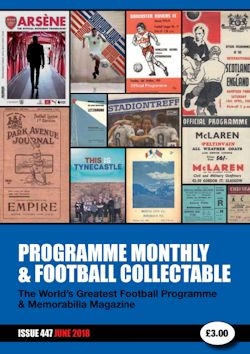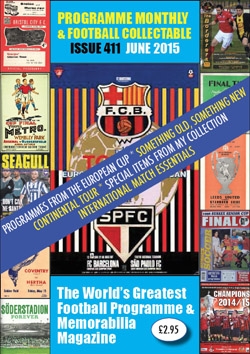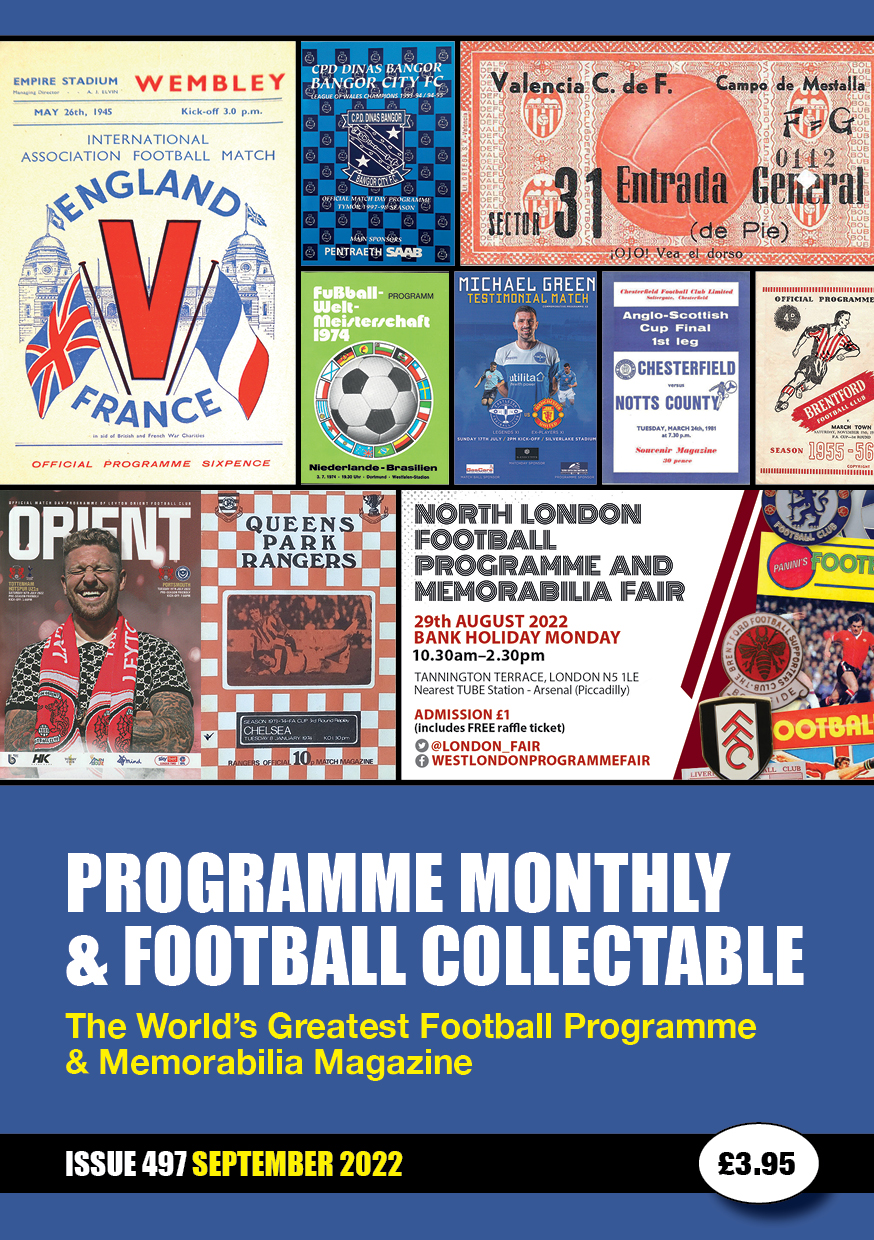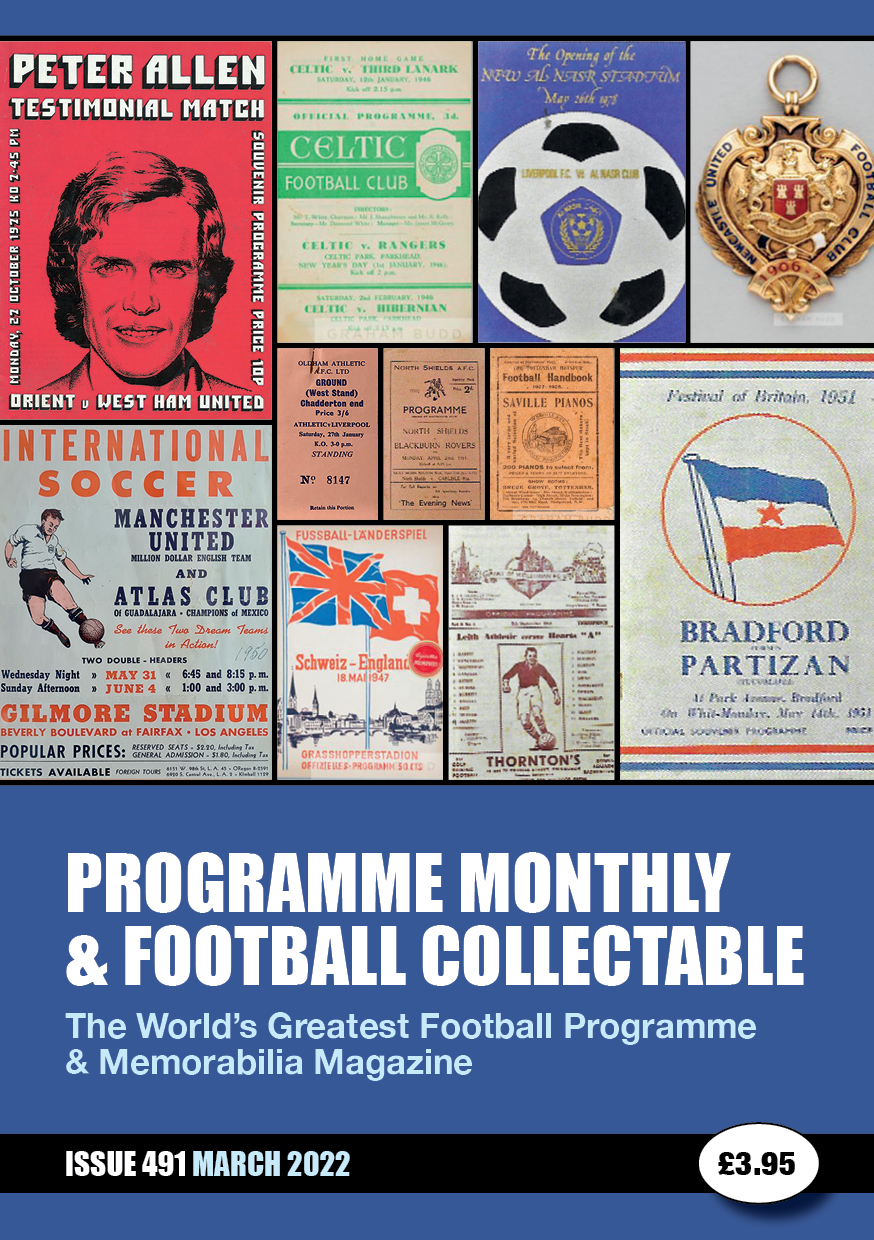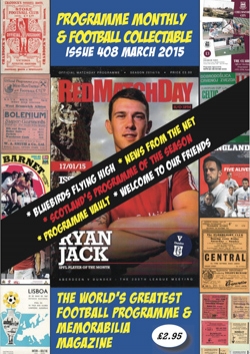100 Issues of Programme Monthly
“Programme Monthly” was undoubtedly conceived in a moment of great weakness, but the forces which moved one eejit to spend the best part of 100 months tapping away at a succession of typewriters, must surely have been present before birth! Let the geneticists, psychologists and psychiatrists worry about that one – we will confine ourselves to the facts in this account of the development of “The World’s Greatest Programme Magazine”.
In the Beginning...
The origins of the writer’s interest in football programmes (from 1967) have been chronicled previously in these pages, but it was not until June 1972 that the first directly formative influence in “Programme Monthly” appeared – a rudimentary 11 page booklet named “Football Market”. It was also known as “Footballana” and was edited by Bryan Horsnell. There was a pre-printed front cover, with the issue number and month over-stamped each month, and the remaining 10 pages were produced on a roneo-machine, printed one side only. There were two or three small articles on items from Bryan’s collection, and the remainder comprised lineage adverts, mostly featuring the Hornsell Collection.
Around this time, came membership of Norman Lovett’s British Programme Collectors Club which, at its very best in the early 70’s, had an informative and entertaining members’ bulletin. A keen interest in collecting programmes was developed in 1973 with the launch of Scotland’s first proper list-issuing programme dealership, “The Rutherglen Programme Exchange”, which finished on a high note with the last of a series of bumper catalogues, listing programmes right back to the war-years.
The dealership lasted just over a year, though it was sufficient to spawn the Scottish Programme Fair and encourage many others to deal and dabble in football programmes. The writing bug had caught on, however, fuelled by the publication of a series of articles in “Football Market’s” successor, “The Football Programme Directory”, launched by Rev. David Wiseman. The Directory was a marvellous innovation in its early years, putting collectors in touch with one another, providing a means of cheap advertising (much needed since the demise of “Soccer Star”, and expanding the role pioneered by Bryan Horsnell, of providing programme collectors with reading material on their hobby. Encouraged by the Rev Wiseman’s example, your would-be writer launched a purely Scottish equivalent, “The Scottish Programme Review”, in April 1977.
This publication helped establish the hobby north of the border, and while advertising was carried, the main thrust of its contents were news, views, information, surveys and articles on programmes and programme collecting. In August 1978, the format was changed from A4 (stapled at the top left hand corner) to A5 with a centre staple. From the SPR came the Scottish Programme Club, although work and other commitments forced the Editor to hand over his ‘baby’ to Rikki Raginia in May 1979, after 26 editions. By then, the magazine was called “Programme Review”, with the intention to penetrate a wider market thatn the purely Scottish one. Increasing interest was being shown south of the border, where the FPD had changed hands a couple of times and had lost its way from its original intentions. Correspondents in Issue No.26 of “Programme Review” were Roy Calmels (Non-League Review), Sheffield-based Peter Rundo reviewing English League programmes, Pete Butcher with an opinion or two, and familiar advertisers such as Dick Fenwick, John Wilson, The Glasgow Programme Shop, Alan King, Peter Riches, Paul Clarkson, Sports Programmes, Peter Holtom and Malcolm Dallison.
White Rikki Raginia laboured manfully with the “Scottish Programme Review” (the “Scottish” was restored after a readership vote – a bit like getting the turkeys to vote against Christmas – the founder was working in the English Home Countries, and, after nearly six months stuck out in rural Buckinghamshire, was becoming bored! Hence, in issue No.43 of S.P.R (November 1980), the Editorial started with the following announcement:
“Welcome to the belated November issue, which will be my last as Editor of the SPR. With effect from January 1981 the magazine will be incorporated in ‘Programme Monthly’, the new magazine being issued jointly by John Litster and Pete Butcher.”
The Launch of “Programme Monthly”
Another frustrated journalist, Pete Butcher, had devoted more and more of his programme dealer’s catalogue to points of view on programmes and collecting, rather than listing programmes for sale. He had made it known that he wished to launch at Peter Rundo’s house outside Sheffield. Agreement was reacher as too a joint collaboration, and the details were hammered out over endless cups of coffee in a Guildford hotel lounge. Through their various contacts in their “other lives” within the hobby, articles were received from ‘experts’, and a printer was chosen, Chadwell Heath based part-time programme dealer Len Llewellyn.
From the distance of over 8 years, it is impossible to recall ‘who thought of what’ when it came to inventing the magazine. The name? Price (35p – 5p more than S.P.R latterly), format and features? One or the other invented or innovated. Pete Butcher, as a member of the Norman Lovett-inspired “programme Dealers’ Association” insisted on a close link with that organisation, and the magazine was originally intended as a ‘trade paper’, reflecting the views of dealers, with collectors something of a secondary consideration. Indeed, there was more than a mild hint that you had to be a member of the P.D.A to advertise in “Programme Monthly”. The format of the magazine was partially borrowed, partially new, but there was one key innovation – the magazine was freely on sale. It could be subscribed for directly, or bought via dealers lists or at club shops, providing a ready-made widespread audience. This was very much a first for programme literature, which had hitherto been available only on subscription or through a membership.
Issue number 1
It would be nice to report that the magazine has never looked back from Issue No.1, February 1981 – but in truth the first six months were far from easy. Half typed in Worthing, the other half put together in Bucks., somehow or other it all came together – usually late – with around 100 subscribers receiving their copies from Worthing, and the 600 – 1000 other readers obtaining their’s from dealers and club shops, many of whom remain as much-valued agents.
Such a partnetship, geographically distant, was never going to work, and it was something of a miracle that the first six months were survived. Circulation rose steadily as the magazine took shape. It may look crude and unprofessional to today’s eye, but it was considerably better than anything hitherto produced for the hobby. There were some first class articles and innovative features. A valuable lesson was learned in those formative issues, however. A good quality product may be one thing, but equally important is top class service to clients. As quickly as sales rose, so they fell as the magazine was produced later and later each month; it didn’t appear at all in July, and issue No.6 was labelled “August/September”, and was probably nearer the latter than the former. A full time job (as a journalist on a local paper!) forced Pete Butcher to resign, and, somewhat fearful of the enormity of the task which lay before him, the surviving editor telephoned Haskall Solomon and David Graham in nearby Watford.
Coincidental with the launch of PM earlier in the year, they had first published “Football Scene and Collectors Review”, a very polished, professional and substantial magazine for football fans and programme collectors. Their response to overtures on some form of amalgamation hinted at the problems they were facing; “I wouldn’t have though you would have any problems with ‘Programme Monthly’, one of them said, a couple of months before their own magazine folded.
With some relish and a little trepidation, it was on with the show – as a one-man band. Superficially at least, the magazine is unrecognisable today from its first few issues. These were produced on an office typewriter after hours and at weekends. Early illustrations were crude and paper, printing and covers were based on economy rather that effect. The purpose of an IBM gold-ball typewriter greatly improved the Editor;s life-style, if not the magazine’s standards. The magazine was then prepared at home, and the “correction-key” was a god-send to someone whose two-fingered, totally untutored typing was rather too fast for its accuracy.
In late 1974, a further step forward was taken typographically with the purchase of an Olivetti daisy-wheel electronic typewriter, complete with margin justification centering etc. (The IBM went to Gauldry to churn out Peter and Kath Rundo’s catalogues). The next stage is desk-top publishing and word-processing on a computer, complete with laser printer. Such capital investments tend not to be taken into account when people complain about the cost of magazines which strive for higher standards…
Despite outward appearances, the magazine has changed little in its basic philosophy since February 1981. it is now completely independent of outside influences; the initial flirtation with the PDA was short-lived; here was a 12 month partnership with Sports Programmes and Ian Rennie when PROSPORTS was formed to promote all aspects of the hobby; and there was a close relationship with PACT in its founding years. The underlying philosophy is unchanged – the intention remains to produce a quality magazine which provides entertainment, information and a forum for discussion on programmes and programme matters.
To achieve the required quality, the best printing and design techniques that can be afforded will be employed. Quality in terms of content is constantly sought – those with anything to say on the hobby are most welcome to submit articles, news, views etc. it may take a number of months, but correspondents may be guaranteed that their contributors will appear in print, unabridged, provided that the content is not sufficiently scurrilous to harm the hobby.
Amid the orgy of self-congratulations in this 100th issue, no sight is lost of the basic fact that the magazine would be nothing without the excellent articles and information supplied by readers. More obviously, advertisers and those who purchase the magazine ensure its survival. It is not a cliché, but a truism, that the magazine belongs to programme collectors - without them, it would not exist and their preferences and viewpoints shape the content and style of “Programme Monthly”.
A number of obstacles have had to be overcome in the development of the magazine, not the least of which is the apathy, and more understandable pre-occupation, of readers when it comes to contributing articles and information. Modern life for many is too hectic to include such niceties as writing letters to PM, and that is recognised. An early hurdle was the peculiar psychology of some programme collectors. To appreciate this, it must be remembered that programme collecting was a very close-knit, almost private pursuit for many years. It was dominated with programme collecting.
They tended to assume that everything done in the hobby was entirely for their benefit, and there was some resentment at having to pay increasing sums of money for an improving product such as a programme magazine. There may also have been a little resentment at the widening of the knowledge-base of the hobby, and a weakening of their self-appointed position of “expert” on all things connected with football programmes. Time has eroded this unattractive influence, to a point where it rarely rears its head.
Money makes the world (and the hobby) go round, and is also the root of all evils. “Programme Monthly” has always sought to expose and condemn exploitation in the hobby. Alongside this stance, however, is the realisation that programme collecting and trading is fundamentally a business. Market forces determine that there is a demand for Offers Sections on dealers lists and in the advertising pages of PM. They determine that, in order to remain in business, dealers must make a profit on programmes they buy and sell. They determine that “Programme Monthly” itself has to cost a certain amount, to make worthwhile to the people who produce the magazine the countless hours of effort each and every week.
Disappointments have been manifold, and continue, although they are subordinate to the satisfaction obtained through the magazine’s growth. Bad debts from agents (e.g. former programme dealers and club shop managers) have amounted to well over £1000. Minor differences of opinion, or perhaps unwise statements made in the magazine, have soured relationships. Time, and the wisdom that comes with maturity, have minimised new instances, but old conflicts leave lasting memories, and many regrets. The main and continuing disappointment is shared by every business – sales could always be better!
This is the perfect opportunity, on a personal note, to thank everyone for the part they have played in 100 issues of “Programme Monthly”. Readers and advertisers; Liz for her unstinting support, Shaun and Vicky for their resigned acceptance; Agents for their help in distributing the magazine and “spreading the word”; the four printing companies involved in 100 issues and their employees; correspondents, who have made this magazine what it is. Every letter, every news item and every article is thoroughly appreciated for being the lifeblood of the magazine. Sincere thanks to all those who have written, and a special thanks to the regular correspondents. Their names are not mentioned purely to avoid offending someone who may be inadvertedly omitted by name.
Thanks for the last 100 issues, here’s to the next 100 and more, because “Programme Monthly” is committed to continued expansion and development to improve the quality of its service to programme collecting and programme collectors.


